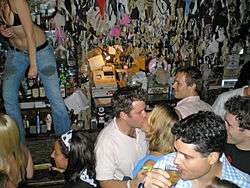Table dance
_(LOC)_(5268915685).jpg)
Table dance, or bartop dancing, is typically an erotic dance performed at (or on) a patron’s table, as opposed to on a stage. In some jurisdictions, a table dance may be an alternative to a lap dance, due to laws preventing exotic dancers from making contact with customers. For example, in Waterloo, Ontario, a table dance is performed on a small portable platform the dancer takes around to patrons’ tables.[1]
Establishments

Similar is the bartop dance, performed for the entertainment of those seated at the bar. The film Coyote Ugly ushered in a fad of bartop dancing establishments. Set in New York City's bar of the same name, several establishments around the city (e.g. Coyote Ugly, Hogs and Heifers, Red Rock West Saloon, Doc Holliday's Saloon) actively encouraged women to jump on the bar and dance, contributing to an "Anything Goes" atmosphere. Hogs and Heifers encourages dancers to leave their brassiere hanging from the ceiling to commemorate their dance. However, table dancing is forbidden at many events and establishments.
Table dancing by patrons (both male and female) became more common in New York after the enforcement of the City's cabaret licenses (required for dancing establishments) was relaxed around the time of the 2001 election of Mayor Michael Bloomberg. The Hilton sisters, Paris and Nicky were reputed to be constant table dancers, but Nicky explained that they only dance on the banquettes. At another restaurant, Kim Cattrall, Candace Bushnell and Patricia Duff were seen table dancing together. Explanations ranged from fun to being seen.[2]
Other forms
Another form of table dance is practiced at traditional events like in Brazilian, European and Australian Carnivals, in German beer tents during Oktoberfest, and at other similar events. However, this kind of table dance is not of an erotic nature. As this dance often leads to accidents, especially if performed by intoxicated individuals or when tables collapse, it is forbidden at many events but dancing on chairs or benches may still be allowed.
See also
References
| Wikimedia Commons has media related to Table dancing. |
- ↑ Pender, Terry (February 12, 2008). "Table dancing here to stay". vThe Record (Waterloo Region). Retrieved 2008-02-24.
- ↑ Bob Morris (August 11, 2002). "THE AGE OF DISSONANCE; Tabletopping Exuberance". The New York Times. Retrieved 2008-02-25.